5 NOVEMBER 2012
YOUR WORDS
Readers are invited to add their comments to any story. Click on the article to see and add.
BTN DISTRIBUTION
BTN also goes out by email every Sunday night at midnight (UK time). To view this edition click here.
The Business Travel News
PO Box 758
Edgware HA8 4QF
United Kingdom
info@btnews.co.uk
© 2022 Business Travel News Ltd.
Article from BTNews 5 NOVEMBER 2012
ON TOUR: North Wales
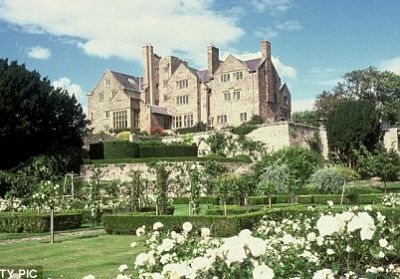 North Wales is a long way from London (but not so far from Manchester and other points in the north). Llandudno is arguably the capital and 250 miles from Marble Arch. The M1, M6 and M54 make for easy going at first and a dual carriageway follows until Wrexham and then it gets worse and worse along hilly single lane roads. But at least the scenery is magnificent. An alternative southern route takes you through the Snowdonia National Park, simply wonderful views. Reckon on five hours including a 30-minute stop.
North Wales is a long way from London (but not so far from Manchester and other points in the north). Llandudno is arguably the capital and 250 miles from Marble Arch. The M1, M6 and M54 make for easy going at first and a dual carriageway follows until Wrexham and then it gets worse and worse along hilly single lane roads. But at least the scenery is magnificent. An alternative southern route takes you through the Snowdonia National Park, simply wonderful views. Reckon on five hours including a 30-minute stop.
An alternative routing might be Virgin Rail and the hire of a car at the other end. Train fares can be very cheap and vehicle rental likewise. Euston to Llandudno Junction is around 2hrs 50mins and a departure every hour.
We took a two-night break but would suggest a week to fully appreciate some of the finest scenery in the United Kingdom and true local hospitality.
Bodysgallen Hall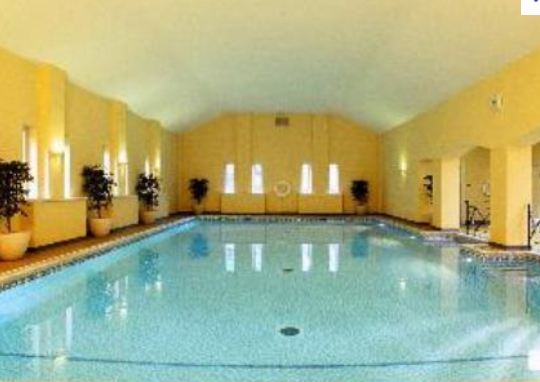
It is a Grade I listed building which makes its running as a hospitality unit not that easy, but the ‘AA Hotel of the Year for Wales 2012-2013’ says it all. You are made very welcome in a truly wonderful setting.
Visitors to Bodysgallen Hall have a choice. Either stay in the main hotel with its 15 rooms, or in one of the buildings in the grounds (which extend for 200 acres). My own view is to locate within the house in the winter (unless on honeymoon) and stay in one of the very large self-contained cottages in the summer. There is a large spa and indoor swimming pool which attracts locals, and new for this year Bistro 1620. If the superb main restaurant is anything to go by it should be ideal for a less formal meal. The hotel lists a series of 30-minute walks through the superb grounds. We also ate at the Queens Head, Glanwydden, which we would also recommend. www.bodysgallen.com www.queensheadglanwydden.co.uk
Welsh Highland Railway North Wales is full of railways, some part of the national network, and others restored tracks and the remnants of long disused slate and coal works. Perhaps the most famous are the narrow gauge Snowdonia Mountain Railway and the Ffestiniog Railway.
North Wales is full of railways, some part of the national network, and others restored tracks and the remnants of long disused slate and coal works. Perhaps the most famous are the narrow gauge Snowdonia Mountain Railway and the Ffestiniog Railway.
We chose to take a ride on the Ffestiniog’s sister operation, The Welsh Highland Railway, steam driven and 26 miles of fantastic scenery in the National Forest. It is not very fast but it chugs along beautifully. You can go from Caernarfon to Porthmadog (and back) but we chose to join at Rhys Ddu, a village with a pub about half way along, and easy parking.
Porthmadog is where the Welsh Highland and the Ffestiniog meet, a once flourishing industrial port and now a yacht haven. There is a small extra charge for the Pullman Observation Car, well worth the extra. Each carriage is different, the third class specimen out in the open and great fun, except when going through a tunnel. Quite an experience. www.festrail.co.uk
Portmeirion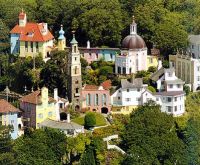 Owned by a charitable trust Portmeirion is about one hour’s drive from Bodysgallen Hall either along the coast road via Bangor or the much more exciting cross country mountain route. To really make the most of the village stay at least one night in the on-site accommodation ranging, from 4-star to self-catering. You will not be disappointed
Owned by a charitable trust Portmeirion is about one hour’s drive from Bodysgallen Hall either along the coast road via Bangor or the much more exciting cross country mountain route. To really make the most of the village stay at least one night in the on-site accommodation ranging, from 4-star to self-catering. You will not be disappointed
Whilst there is the remains of a medieval castle in the extensive grounds Portmeirion is essentially a living memorial to the architect Sir Clough Williams-Ellis who, from 1925 onwards, constructed a fantasy tourist village on a site overlooking the wide River Dwyryd.
“Clough” as he was always known died in 1978 but not before persuading influential people, such as the Prince of Wales, on the value of the project not only as a wonderful tourist location but also the repository of Victoriana that otherwise might have been destroyed. The Bristol Colonnade and the Town Hall (rescued from Emral, Flintshire) are typical.
Portmeirion has served as the location for numerous films and television shows, most famously serving as The Village in the 1960s television show The Prisoner. Visitors will find numerous buildings and structures to investigate. There is a continuous 40-minute video show with Clough as the compare, wearing distinctive yellow socks.
New for this year is the Forest Train, all part of the entrance fee, which takes visitors as far as an area known, for obvious reasons, as the Japanese Bridge. It takes 20 minutes or you can get off and pick it up next time around, or walk back.
Portmeirion Pottery was founded in 1960 when Clough’s daughter Susan took over a small pottery decorating company in Stoke-on-Trent and Portmeirion Potteries was born. Portmeirion's most recognised design is the Botanic Garden range, decorated with a variety of floral illustrations. It was launched in 1972 and is still made today. In 2009 the Royal Worcester and Spode brands were purchased after they had been placed into administration. The manufacture of much of Spode's ware was returned to the Portmeirion factory in Stoke-on-Trent from the Far East. www.portmeirion-village.com
Bodnant Gardens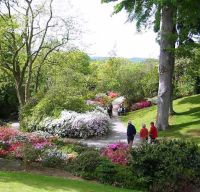 Close by the A470 Llandudno – Betws-y-Coed road lies Bodnant Gardens, still the home of the Dowager Lady Ann Aberconway, the majority now a National Trust property covering 80 acres above the River Conwy on ground sloping towards the west and looking across the valley towards the Snowdonia range. For the first time the gardens will be open during the winter which should make for some spectacular views. Parking is across the road and there is a pedestrian underpass. The on-site café was excellent and there is a fine garden shop.
Close by the A470 Llandudno – Betws-y-Coed road lies Bodnant Gardens, still the home of the Dowager Lady Ann Aberconway, the majority now a National Trust property covering 80 acres above the River Conwy on ground sloping towards the west and looking across the valley towards the Snowdonia range. For the first time the gardens will be open during the winter which should make for some spectacular views. Parking is across the road and there is a pedestrian underpass. The on-site café was excellent and there is a fine garden shop.
The Garden has two parts. The upper garden around Bodnant Hall consists of the terraced gardens and informal lawns shaded by trees. The lower area, known as the "Dell" is formed by the valley of the River Hiraethlyn and contains the Wild garden. The rise between the two is quite steep
An endeavour has been made at Bodnant Garden to grow a wide range of interesting and beautiful plants from all over the world, particularly China, North America, Europe and Japan, that are suited to the Welsh climate and soil. As well as this, care has been taken to place the plants in such a way that they enhance each other and contribute to the general beauty of the Garden throughout the seasons. www.nationaltrust.org.uk/bodnant-garden
Chirk Castle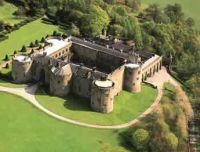 Just outside Wrexham is Chirk Castle, a fine National Trust property, magnificently perched on top of a hill. It was started in 1295, one of a series of fortifications built to protect the North West from the Welsh Kings.
Just outside Wrexham is Chirk Castle, a fine National Trust property, magnificently perched on top of a hill. It was started in 1295, one of a series of fortifications built to protect the North West from the Welsh Kings.
It is not that well signposted, but is only a 30-minute walk from Chirk railway station. Allow another 15 minutes for the steep climb from the entranceway, farm shop and countryside display room.
The Castle is very well preserved and built around a rectangle. In the Civil War its then owner Thomas Myddelton was a Parliamentarian who refused to use cannon against the building when it was held by the Royalists. Cromwell was not for him and he changed sides supporting the return of Charles. The Myddelton family retained a private suite in the castle until 2005. They are not related to the Duchess of Cambridge.
There are various tours of the castle and grounds and it is best to check on the website in order to get your timings right. The various rooms are perfectly preserved in 17th century, Georgian and Victorian styles, and it is also possible to visit the dungeons, a grim and dark experience. Just opened is the newly refurbished East Wing rooms where you can discover the fascinating story of Thomas Scott Ellis, eighth Lord Howard de Walden; the man many consider to be the last great patron of Welsh art. Tommy to friends and family, Eton and Sandhurst, Boer War and Great War veteran, race horse owner, playwright and theatre impresario turned the 14th century chapel into a concert hall (which is still used). George Gershwin and Noel Coward were both guests in the years between the two World Wars. www.nationaltrust.org.uk/chirk-castle
The North Wales Tourist Board operates an accommodation booking line +44 (0)8705 168767. www.gonorthwales.co.uk
OUR READERS' FINEST WORDS (All times and dates are GMT)
All comments are filtered to exclude any excesses but the Editor does not have to agree with what is being said. 100 words maximum
